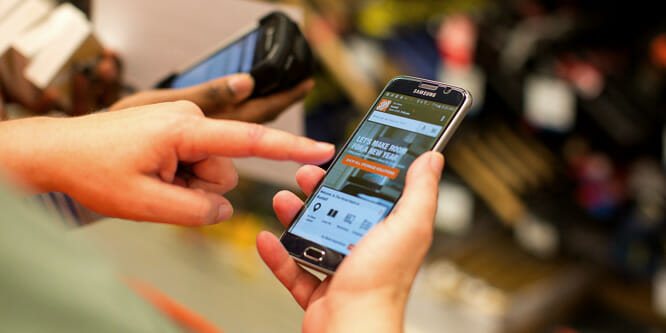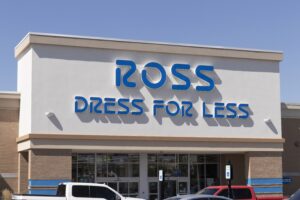
Photo: Home Depot
December 1, 2017
What is increased mobile holiday traffic doing for sales?
The data coming out about the first leg of the holiday season is beginning to reveal insights about the changing way people shop. What exactly they say about mobile commerce, though, is up in the air.
From Nov. 1 through Thanksgiving, smartphones accounted for 46 percent of online shopping traffic vs. only 44 percent from desktop machines, according to Business Insider. But smartphone traffic only accounted for 29 percent of sales while desktop made up 59 percent. So, mobile traffic doesn’t necessarily translate into customers buying from their smartphones.
And while retailers like Home Depot, as reported in DigiDay, had an increase in Black Friday mobile traffic that analysts attributed to a superior mobile experience, the chain did not release specific sales details. It is also not clear whether the touted features like single-page checkout, live chat and localized promotions on Home Depot’s mobile site drove more than traffic.
The lack of a corresponding sales uptick with mobile traffic could indicate that mobile is serving a more complicated set of practices by shoppers. It could even point to an increase over the holiday in showrooming. Customers may be visiting physical retail outlets and comparing prices via mobile before purchasing a product at a cheaper outlet or buying it online.
The behavior raises questions — if certain mobile functionality could help retailers capture sales from showrooming customers or if mobile sites could be more effective in getting users to take advantage of BOPIS deals than desktop websites.
That said there are some retailers that have gotten a significant boost from a top-notch mobile presence year-round.
Sephora, for instance, attributes its ongoing success to its dedication to using mobile as the “glue” between the in-store an online experience. But the way the chain ingrains its mobile experience at every step of the customer journey extends beyond a passive mobile website. Among other things, daily mobile content actively draws eyes to the site, and targeted, localized mobile promotions are automatically texted to nearby customers.
- On Black Friday, Home Depot saw more mobile traffic than desktop – Digday
- Thanksgiving e-commerce growth surges from 2016 – Business Insider
- Home Depot shares hit all-time high as housing momentum swells, company advances mobile initiatives – CNBC
- How did mobile become the ‘glue’ in the Sephora shopping experience? – RetailWire
Discussion Questions
DISCUSSION QUESTIONS: Does increasing mobile traffic warrant greater retailer investment, even if there is not a corresponding increase in direct sales? Where do you see the biggest opportunities for retailers to use mobile tech to support their sales objectives?
Poll
BrainTrust
Dick Seesel
Principal, Retailing In Focus LLC
Gene Detroyer
Professor, International Business, Guizhou University of Finance & Economics and University of Sanya, China.
Ryan Mathews
Founder, CEO, Black Monk Consulting
Recent Discussions







The answer to the question depends on which retailer you’re talking about. Amazon (for example) makes the process of buying directly from your smartphone app as simple as possible, so it’s easy to buy without having to reach for your laptop. On the other hand, some transactions are more complex (for example, the dishwasher we bought after Thanksgiving) and really benefit from a bigger keyboard and screen to “close the deal” — even if the initial searches happen on the smartphone screen. (At least that’s true for this troglodyte.)
Lesson learned for all e-commerce and omnichannel retailers: Follow the Amazon model where possible, and make the transaction as easy as you can — from search to selection to checkout. If more retailers follow this example, the smartphone share of wallet will continue to grow at a rapid rate.
It’s becoming increasingly apparent that formulating the right digital-first mobile strategy is the conduit to a sustainable overall retailer and consumer relationship. With the digital transformation clearly in swing, significant investments in digital will enable retailers to solidify their brand and connect with existing and new customers.
There is a direct and measurable relationship between digital engagement and the ultimate sales transaction. An engaging, transporting, socially connected mobile experience will lead to the consumer shopping directly online, potentially visiting the brick-and-mortar store or a hybrid of the two if they choose to showroom the product.
In short, a digital-first mindset and company strategy is paramount to success for retailers. I am in full agreement with Sephora’s approach, as there is no real distinction between “technology” and the overall customer experience. It is indeed the glue that will lead to sustainability and relevance.
Brandon’s use of the word “digital” is perfect. Retailers too often try to silo communication devices — the smartphone is different from the tablet is different from the laptop, etc. The user does not distinguish one device from another (the world is likely to move to a single device with the only difference being the size of the screens). Digital will be all-important. It will ultimately be the primary tool for purchasing anything any retailer who tries to hack the consumer’s mind will be disappointed.
I couldn’t agree more Gene. Siloing your channels, i.e., the multichannel strategies of the 2000s is simply not going to work in today’s dynamic digital-first marketplace.
Consumers simply desire to engage with a brand and are agnostic about which channel they ultimately choose to complete the transaction. It is imperative for retailers and brands to know and understand that this does not only apply to the Generation Z or Millennial segments. Rather, people as a whole are engaging and using their smartphones in all aspects of their lives, including shopping, researching, finance and social engagement.
There should be no distinction between your online or brick-and-mortar strategies. Rather a fluid, agile, flexible and evolving strategy should be in place.
Mobile devices today have become mini-computers in the palm of our hand. It’s not hard to understand that consumers are browsing on their phones because we can’t seem to put them down. Buying with mobile still has some limitations primarily because of screen size and keyboarding challenges, which makes the desktop a bit easier and probably why the actual sales are currently higher on desktop computers. However, technology continues to improve, and that will boost mobile device buying on its own. That said, retailers need to stay in the game by having top-notch mobile sites that are easy to navigate and, when the customer wants, easy to purchase from.
Mobile traffic will shift the sale from some other channel to mobile. That said, it remains incumbent upon retailers to realize that the shift (not increase) in sales is taking place and be prepared to offer it, support it and enhance it.
Retailers need to invest in mobile. Yes, consumers may be using their phones to compare prices or do produce research, but every consumer touchpoint needs to be developed and exploited, because not doing so could mean a competitor gets the sale.
We need to stop thinking in terms of these, “either/or” choices. It isn’t mobile versus laptop, or tablet versus voice activation, or the Internet of Things versus mail order or even physical stores versus digital commerce. It’s shopping. The interesting thing about the history of media is that almost no platforms ever goes away. Radio did not kill print. Television did not kill radio. Cable television and satellite radio did not kill off ABC, NBC, CBS or many traditional radio station operators. Streaming didn’t eliminate broadcast. And VR won’t replace flat screens. The same thing is true of shopping platforms. People will use phones for some functions, laptops for others, IoT — maybe one day, subscription services and and number of other options. Oh … and some folks will still clip paper coupons.
We need to understand that each of these elements is just a node in a consumer’s personal shopping ecology — used whenever most convenient or appropriate. That’s what’s wrong with the omnichannel argument. It overlooks the long game by overly focusing on platforms. So yes, retailers should invest in any and all platforms that facilitate a purchase — directly or indirectly. The rest of it is common sense. As Dick Seesel points out, there probably isn’t much demand for mobile when you are filling out long and complex forms. But you might see an item — say in a store window — spot check pricing, availability, options, etc. on your phone, think about whether you really want the item for a few hours and then make your final purchase decision later at home on your laptop or desktop. The phone has clearly had a pivotal role in the process, no matter where the final click occurs.
Yes, make the investments now. The issue of conversion to actual sales will soon resolve itself as customers become more accustomed to shopping with mobile devices and more and more retailers provide better experiences for mobile shoppers.
Sephora’s success points to near-term opportunities. Pushing out localized content and promotions to nearby customers is a relatively easy win area for retailers.
The trend of increased shopping and buying via mobile isn’t going to slow soon. In response to the question, yes, retailers should be investing in improvements across technology, stores and sites to improve the mobile shopping experience. In-store interaction via mobile phones has great promise for promotions and service.
Again, this is all about true, real-time personalization to follow (or better yet, LEAD) the shopper through their journey and offer relevant options to assist them with any online struggles as they happen. This is possible, and we’re seeing some great retailers achieving this nirvana state. This is a huge opportunity for smaller retailers to outpace the bigger ones with a more compelling mobile experience.
Mobile devices are now consumers’ preferred method for shopping for products online, but not necessarily consummating the sale. Whether they make their final purchase from their phone or if they choose to switch to their desktop computer or visit a store for the transaction, the importance of the optimizing the shopping experience on mobile devices is critical for retailers. Retailers need to adopt a “mobile first” strategy for their online experience. If you don’t, you will alienate your customers and risk losing sales to your competitors.
Beyond making your website mobile friendly, retailers should add mobile features that make the in-store shopping experience better – like identifying customers when they enter your store, providing personalized recommendations and offers that are customized based on their preferences and product locator maps. In addition to customer-facing mobile tools, it is also imperative to give your sales associate even more mobile capabilities to enable them to offer personalized services to customers. The fact is that the small screen form factor of mobile is an issue despite the increase in screen size with recent smart phone models … people like to finalize their sales they began on mobile with their laptop or desktop.
Investment in mobile technology needs to be with the long term in mind. Retailers who wait until there is a proven shift in sales impact of mobile technologies to build it may find that by the time they have, they’ve lost these customers to others who were ahead of the curve.
Numbers from the NRF show that millennial spend dominated in the recent holiday sales. Forward thinking retailers will implement now what this demographic will want tomorrow; and I believe that will become mobile-first-style shopping.
My bottom line: This is interesting. It may offer opportunity or simply replace existing activity. It also creates new problems for which retailers will have to sort out ways to respond.
Caution is required when looking at this move.
What we learned that consumers are doing more browsing/interaction on mobile devices and less on desktops. Nothing more.
Okay. But since mobile providers have filled the air with incredible exaggerations about what this “will mean,” there’s an exaggerated response claiming this is a good thing. But wise retailers will recognize all we know is a fact: a shift in browsing interaction.
Then those retailers have to worry about whether this is a good thing. After all, mobile (non-tablet) activity is far inferior communication to desktop, TV, radio, print, or outdoor. So there’s incredible risk that we’re teaching people to avoid shopping, to limit their choices to a tiny set of options about which they already know, and eliminating our opportunity to communicate.
If I’m right about that, it means fewer new products succeed, less retailer differentiation, and retailers will have to increase obnoxious infiltration of daily activities as implied by the Sephora discussion.
Let’s see what happens from here. But let’s also not cheer this result too much.
The increased traffic of mobile users on e-commerce sites isn’t necessarily related to sales. In fact, data shows that even though more and more users are looking for items through their mobile phones, most of them are still buying online using their laptops or computers, which is a critical fact retailers should consider. From personal experience, the only factor that leads me to use my computer to buy an item I’ve previously seen on mobile is simply a better customer experience on the desktop. Retailers should be aware of the potential that an improved mobile experience holds for increased online sales.
Online traffic is one thing. Mobile can drive store traffic as well. As the author suggests, Sephora prompts shoppers to visit stores with an app that enables virtual try-on.
In more mainstream categories, Target, Walgreens and Kohl’s stand out. Target’s Cartwheel app is built specifically for in-store customers by showing consumers local deals and allowing stacking with other promotions. Walgreens’ mobile experience helps shoppers refill prescriptions easily. The app also provides in-store couponing. The Kohl’s app rewards 10 points for accessing the app in-store and tracks users’ Kohl’s cash.
Pre-store, other retailers are increasingly invoking BOPIS on mobile. In-store, Bluetooth Low Energy solutions drive relevant offers.
Meanwhile retailers like Home Depot, as reported in DigiDay, had an increase in Black Friday mobile traffic that analysts attributed to a superior mobile experience, the chain did not release specific sales details.
What we learned is that consumers are doing more browsing/interaction on mobile devices and less on desktops. Nothing more.